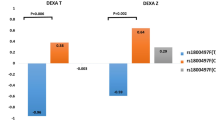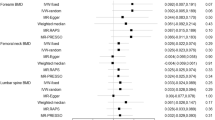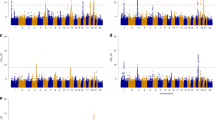Abstract
A –521C→T polymorphism in the promoter of the dopamine receptor D4 gene (DRD4) has been associated with novelty-seeking behavior in Japanese. Given that the dopaminergic system might also play an important role in bone metabolism, the relation of the –521C→T polymorphism of DRD4 to bone mineral density (BMD) was examined in 2,228 Japanese subjects (1,123 men; 1,105 women) who were randomly recruited to a population-based, prospective cohort study. BMD at the radius was measured by peripheral quantitative computed tomography, and that for the total body, lumbar spine, right femoral neck, right trochanter, and right Ward’s triangle was measured by dual-energy X-ray absorptiometry. Genotype was determined with a fluorescence-based allele-specific DNA primer assay system. For men, BMD for the distal radius, total body, lumbar spine, trochanter, or Ward’s triangle was lower in individuals with the CC genotype than in the combined group of TT and TC genotypes or in those with the TT genotype or with the TC genotype. The urinary concentration of deoxypyridinoline was slightly, but significantly, greater in men with the CC genotype than in those with the TT or TC genotypes or with the TT genotype. For women, there were no differences in BMD among –521C→T genotypes. These results implicate DRD4 as a candidate locus for reduced BMD in Japanese men.
Similar content being viewed by others
Introduction
The dopaminergic system participates in various physiological processes that affect cardiovascular-renal function, including control of blood pressure and maintenance of electrolyte balance, as well as in reproduction and regulation of cell calcium homeostasis (Gilbert 1993). Altered dopaminergic activity may result in changes not only in renal sodium balance, but also in the renal response to vitamin D, calcium, and parathyroid hormone. Such altered interactions among vitamin D, calcium, and sodium in the kidney have implications for bone metabolism (Gilbert 1993). Dopamine is also essential for ovarian function, and estrogens and androgens in turn increase dopamine turnover. An altered dopaminergic status may thus affect actions of these sex hormones that are associated with qualitative and quantitative attributes of bone (Gilbert 1993).
The dopamine receptor D4 is expressed in limbic areas of the brain that contribute to cognition and emotion (Van Tol et al. 1991) and mediates exploratory behavior in experimental animals (Fink and Smith 1980). Sequence variability within the dopamine receptor D4 gene (DRD4) has been implicated in the personality trait of novelty seeking, which is related to extroversion (Benjamin et al. 1996; Ebstein et al. 1996). A C-to-T single nucleotide polymorphism (SNP) at position –521 of DRD4 relative to the translation start site has been associated with novelty-seeking behavior in independent studies of Japanese (Okuyama et al. 2000) and Hungarians (Ronai et al. 2001). With the use of a transient expression system, Okuyama et al. (2000) showed that the transcriptional activity of the –521T allele of DRD4 was reduced by ~40% compared with that of the –521C allele in a human retinoblastoma cell line, suggesting functional relevance of this SNP in dopaminergic neurotransmission.
We have now examined whether the –521C→T SNP in the promoter of DRD4 is associated with bone mineral density (BMD) in Japanese men or women in a population-based study.
Materials and methods
Study population
The National Institute for Longevity Sciences–Longitudinal Study of Aging (NILS-LSA) is a population-based prospective cohort study of aging and age-related diseases (Shimokata et al. 2000; Yamada et al. 2003). The subjects of the NILS-LSA are stratified by both age and gender and are randomly selected from resident registrations in the city of Obu and town of Higashiura in central Japan. The present study represents a cross-sectional analysis of the NILS-LSA population. Individuals with disorders known to cause abnormalities of bone metabolism, including diabetes mellitus, renal diseases, rheumatoid arthritis, as well as thyroid, parathyroid, and other endocrinologic diseases, were excluded from the present study. Women who had taken drugs that affect bone metabolism, such as estrogen, progesterone, glucocorticoids, and bisphosphonates, were also excluded. We examined the relation of BMD at various sites to the –521C→T SNP of DRD4 in 2,228 participants (1,123 men; 1,105 women). The study protocol was approved by the Committee on Ethics of Human Research of National Chubu Hospital and the NILS, and written informed consent was obtained from each subject.
Measurement of BMD
BMD at the radius was measured by peripheral quantitative computed tomography (pQCT) (Desiscan 1000; Scanco Medical, Bassersdorf, Switzerland) and was expressed as D50 (distal radius BMD for the inner 50% of the cross-sectional area, comprising mostly cancellous bone), D100 (distal radius BMD for the entire cross-sectional area, including both cancellous and cortical bone), and P100 (proximal radius BMD for the entire cross-sectional area, consisting mostly of cortical bone). BMD for the total body, lumbar spine (L2–L4), right femoral neck, right trochanter, and right Ward’s triangle was measured by dual-energy X-ray absorptiometry (DXA) (QDR 4500; Hologic, Bedford, MA, USA). The coefficients of variance of the pQCT instrument for BMD values were 0.7% (D50), 1.0% (D100), and 0.6% (P100), and those of the DXA instrument were 0.9% (total body), 0.9% (L2–L4), 1.3% (femoral neck), 1.0% (trochanter), and 2.5% (Ward’s triangle).
Determination of DRD4 genotype
Genotypes were determined with a fluorescence-based allele-specific DNA primer assay system (Toyobo Gene Analysis, Tsuruga, Japan) (Yamada et al. 2002). The polymorphic region of DRD4 was amplified by the polymerase chain reaction with allele-specific sense primers labeled at the 5’ end with either fluorescein isothiocyanate (5’- GAGCGGGCGTGGAGGXCG-3’) or Texas red (5’- GAGCGGGCGTGGAGGXTC-3’) and with an antisense primer labeled at the 5’ end with biotin (5’- GACTCGCCTCGACCTCGTG-3’). The reaction mixtures (25 μl) contained 20 ng of DNA, 5 pmol of each primer, 0.2 mmol/l of each deoxynucleoside triphosphate, 2 mmol/l MgCl2, and 1 U of rTaq DNA polymerase (Toyobo, Osaka, Japan) in polymerase buffer. The amplification protocol comprised initial denaturation at 95°C for 5 min; 35 cycles of denaturation at 95°C for 30 s, annealing at 65°C for 30 s, and extension at 72°C for 30 s; and a final extension at 72°C for 2 min.
The amplified DNA was incubated in a solution containing streptavidin-conjugated magnetic beads in the wells of a 96-well plate at room temperature. The plate was then placed on a magnetic stand, and the supernatants from each well were transferred to the wells of a 96-well plate containing 0.01 mol/l NaOH and were measured for fluorescence with a microplate reader (Fluoroscan Ascent; Dainippon Pharmaceutical, Osaka, Japan) at excitation and emission wavelengths of 485 and 538 nm, respectively, for fluorescein isothiocyanate and of 584 and 612 nm, respectively, for Texas red.
Measurement of biochemical markers of bone turnover
Venous blood and urine samples were collected in the early morning after the subjects had fasted overnight. Blood samples were centrifuged at 1,600×g for 15 min at 4°C, and the serum fraction was separated and stored at −80°C until assayed. The serum concentration of osteocalcin was measured with an immunoradiometric assay kit (Mitsubishi Chemical, Tokyo, Japan). The activity of bone-specific alkaline phosphatase (ALP) in serum was measured with an enzyme immunoassay kit (Metra Biosystems, Mountain View, CA, USA). Urine samples were collected in plain tubes and stored at −80°C. Urinary deoxypyridinoline was measured with an enzyme immunoassay kit (Metra Biosystems); the values were corrected for urinary creatinine and expressed as picomoles per micromole of creatinine. Urinary creatinine was enzymatically measured with a creatinine test kit (Wako Chemical, Osaka, Japan).
Statistical analysis
Quantitative data were compared among three groups by one-way analysis of variance and the Tukey-Kramer post hoc test, and between two groups by the unpaired Student’s t test. BMD values were analyzed with adjustment for age and body mass index (BMI) by the least squares method in a general linear model. Allele frequencies were estimated by the gene-counting method, and the chi-square test was used to identify significant departure from Hardy-Weinberg equilibrium. A P value of <0.05 was considered statistically significant.
Results
Characteristics of male subjects are shown in Table 1. The distribution of –521C→T genotypes of DRD4 was in Hardy-Weinberg equilibrium for men. Age, BMI, and the prevalence of smoking did not differ among –521C→T genotypes. Height and body weight were greater in men with the TC genotype or in the combined group of TT and TC genotypes than in men with the CC genotype. After adjustment for age and BMI, BMD for the distal radius (D50), total body, lumbar spine, trochanter, or Ward’s triangle was significantly lower in men with the CC genotype than in the combined group of TT and TC genotypes or in those with the TT genotype or with the TC genotype (Table 2). The differences in adjusted BMD between the CC genotype and the combined TT-TC group (expressed as a percentage of the corresponding larger value) were 4.8% (D50), 1.6% (total body), 3.0% (lumbar spine), 3.6% (trochanter), and 4.3% (Ward’s triangle).
Characteristics of female subjects are shown in Table 3. The distribution of –521C→T genotypes of DRD4 was in Hardy-Weinberg equilibrium for women. Age was greater in women with the TC genotype or in the combined group of TT and TC genotypes than in women with the CC genotype. Height was smaller in the combined TT-TC group than in women with the CC genotype. Body weight, BMI, and the prevalence of smoking did not differ among –521C→T genotypes for women. There were no differences in BMD among –521C→T genotypes in women (Table 4). The relation of BMD to –521C→T genotype was also examined in premenopausal and postmenopausal women separately, but no association was detected (data not shown).
The relation of biochemical markers of bone turnover to –521C→T genotypes of DRD4 was also examined (Table 5). For men, the serum concentrations of osteocalcin and bone-specific ALP did not differ among –521C→T genotypes, whereas urinary excretion of deoxypyridinoline was slightly, but significantly, greater in individuals with the CC genotype than in those with the TT genotype or in the combined group of TT and TC genotypes. For women, the serum concentrations of osteocalcin and bone-specific ALP as well as urinary excretion of deoxypyridinoline were greater in those with the TC genotype or in the combined group of TT and TC genotypes than in those with the CC genotype. There were no differences in parameters for renal function, such as blood urea nitrogen or serum concentrations of creatinine, among DRD4 genotypes for men or women.
Discussion
The dopaminergic system plays an important role in the central nervous system by regulating synaptic transmission mediated by the major neurotransmitters and neuropeptides in the hypothalamus, and it performs a combined neurotransmitter-hormone function in the pituitary gland (Gilbert 1993). The effects of the dopaminergic system on the action of sex hormones, vitamin D, and parathyroid hormone may also contribute to the attainment of peak bone mass at a young age and to bone loss later in life (Gilbert 1993).
We have now shown that the –521C→T SNP of DRD4 was significantly associated with BMD at the distal radius (D50), total body, lumbar spine, trochanter, and Ward’s triangle in men, with the CC genotype representing a risk factor for reduced BMD. Measurement of biochemical markers of bone turnover revealed that bone resorption was slightly but significantly increased in men with the CC genotype. In contrast, no association between –521C→T genotype and BMD was observed for women, although women with the TT or TC genotype or with the TC genotype exhibited higher bone turnover. Although several gene polymorphisms have been associated with BMD in men (Gennari and Brandi 2001), the relation of genetic diversity to BMD in males has not been fully investigated. Our results suggest that DRD4 is a candidate locus for reduced BMD in men.
The –521C→T SNP is located in one of the CpG dinucleotides in a GC-rich region of the DRD4 promoter, but its surrounding sequence does not appear to match the recognition motif for any known transcription factor (Okuyama et al. 2000). The C allele of this polymorphism exhibited higher transcriptional activity than did the T allele in a reporter gene assay (Okuyama et al. 2000). In the present study, the CC genotype was associated with reduced BMD in men. Treatment with a dopamine agonist resulted in a slight increase in BMD in men with hyperprolactinemia (Di Somma et al. 1998). If the higher transcriptional activity of the C allele of DRD4 results in enhanced dopaminergic activity, the association between –521C→T genotype and BMD detected in our study is thus opposite to that expected on the basis of this previous clinical study. However, differences in transcriptional activity detected in reporter gene systems do not necessarily reflect differences in the receptor characteristics in vivo. The molecular mechanism that underlies the association of the –521C→T SNP of DRD4 with BMD in men thus remains unclear. Given that the dopamine receptor genes have not been shown to express in the bone, the dopaminergic system may not have direct actions to the bone.
The reason for the gender difference in the association of this SNP with BMD also remains to be determined. The dopaminergic system interacts with various hormones, including androgens (Gilbert 1993). Androgens influence bone development and metabolism. Decreased androgen levels have been linked to lower BMD in men, and there is a strong correlation between hypogonadism in elderly men and hip fracture or osteoporosis (Vanderschueren and Bouillon 1995). It is possible that the –521C→T polymorphism of DRD4 affects the action of androgens in men. The gender difference might be attributable, at least in part, to the differences in the serum concentrations of androgens between men and women.
It is possible that the –521C→T SNP of DRD4 is in linkage disequilibrium with polymorphisms of other nearby genes that are determinants of BMD. Indeed, the p57 gene (chromosome 11p15.5), parathyroid hormone gene (11p15.3–15.1), and calcitonin gene (11p15.2–15.1), all of which have been associated with BMD (Hosoi et al. 1999; Miyao et al. 2000; Urano et al. 2000), are located in close proximity to DRD4 (11p15.5). However, our present results suggest that DRD4 is a candidate locus for reduced bone mass in Japanese men.
References
Benjamin J, Li L, Patterson C, Greenburg BD, Murphy DL, Hamer DH (1996) Population and familial association between the D4 dopamine receptor gene and measures of novelty seeking. Nature Genet 12:81–84
Di Somma C, Colao A, Di Sarno A, Klain M, Landi ML, Facciolli G, Pivonello R, Panza N, Salvatore M, Lombardi G (1998) Bone marker and bone density responses to dopamine agonist therapy in hyperprolactinemic males. J Clin Endocrinol Metab 83:807–813
Ebstein RP, Novick O, Umansky R, Priel B, Osher Y, Blaine D, Bennett ER, Nemanov L, Katz M, Belmarker RH (1996) Dopamine D4 receptor (D4DR) exon III polymorphism associated with the human personality trait of novelty seeking. Nature Genet 12:78–80
Fink JS, Smith GP (1980) Mesolimbic and mesocortical dopaminergic neurons are necessary for normal exploratory behavior in rats. Neurosci Lett 17:61–65
Gennari L, Brandi ML (2001) Genetics of male osteoporosis. Calcif Tissue Int 69:200–204
Gilbert C (1993) Low risk to certain diseases in aging: role of the autonomic nervous system and calcium metabolism. Mech Ageing Dev 70:95–113
Hosoi T, Miyao M, Inoue S, Hoshino S, Shiraki M, Orimo H, Ouchi Y (1999) Association study of parathyroid hormone gene polymorphism and bone mineral density in Japanese postmenopausal women. Calcif Tissue Int 64:205–208
Miyao M, Hosoi T, Emi M, Nakajima T, Inoue S, Hoshino S, Shiraki M, Orimo H, Ouchi Y (2000) Association of bone mineral density with a dinucleotide repeat polymorphism at the calcitonin (CT) locus. J Hum Genet 45:346–350
Okuyama Y, Ishiguro H, Nankai M, Shibuya H, Watanabe A, Arinami T (2000) Identification of a polymorphism in the promoter region of DRD4 associated with the human novelty seeking personality trait. Mol Psychiatry 5:64–69
Ronai Z, Szekely A, Nemoda Z, Lakatos K, Gervai J, Staub M, Sasvari-Szekely M (2001) Association between novelty seeking and the –521 C/T polymorphism in the promoter region of the DRD4 gene. Mol Psychiatry 6:35–38
Shimokata H, Ando F, Niino N (2000) A new comprehensive study on aging—the National Institute for Longevity Sciences, Longitudinal Study of Aging (NILS–LSA). J Epidemiol 10:S1–S9
Urano T, Hosoi T, Shiraki M, Toyoshima H, Ouchi Y, Inoue S (2000) Possible involvement of the p57 (Kip 2) gene in bone metabolism. Biochem Biophys Res Commun 269:422–426
Van Tol HH, Bunzow JR, Guan HC, Sunahara RK, Seeman P, Niznik HB, Civelli O (1991) Cloning of the gene for a human dopamine D4 receptor with high affinity for the antipsychotic clozapine. Nature 350:610–614
Vanderschueren D, Bouillon R (1995) Androgens and bone. Calcif Tissue Int 56:341-346
Yamada Y, Izawa H, Ichihara S, Takatsu F, Ishihara H, Hirayama H, Sone T, Tanaka M, Yokota M (2002) Prediction of the risk of myocardial infarction from polymorphisms in candidate genes. N Engl J Med 347:1916–1923
Yamada Y, Ando F, Niino N, Shimokata H (2003) Association of polymorphisms of interleukin-6, osteocalcin, and vitamin D receptor genes, alone or in combination, with bone mineral density in community-dwelling Japanese women and men. J Clin Endocrinol Metab 88:3372–3378
Acknowledgements
This work was supported in part by Research Grants for Longevity Sciences (12C-01) (to YY and HS) and Health and Labor Sciences Research Grants for Comprehensive Research on Aging and Health (H15-Chojyu-014) (to YY, FA, NN, and HS) from the Ministry of Health, Labor, and Welfare of Japan.
Author information
Authors and Affiliations
Corresponding author
Rights and permissions
About this article
Cite this article
Yamada, Y., Ando, F., Niino, N. et al. Association of a polymorphism of the dopamine receptor D4 gene with bone mineral density in Japanese men. J Hum Genet 48, 629–633 (2003). https://doi.org/10.1007/s10038-003-0090-7
Received:
Accepted:
Published:
Issue Date:
DOI: https://doi.org/10.1007/s10038-003-0090-7
Keywords
This article is cited by
-
The role of GPCRs in bone diseases and dysfunctions
Bone Research (2019)
-
The effects of dopamine receptor 2 expression on B cells on bone metabolism and TNF-α levels in rheumatoid arthritis
BMC Musculoskeletal Disorders (2016)



